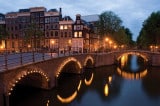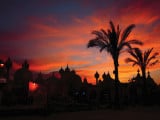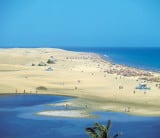As Euro 2012 draw daily nearer, the estimated 20,000 Irish fans travelling to the Ireland games in Gdansk and Poznan will not be short of things to do between matches. Yvonne Moran checks out what’s on offer.
Picture the scene: two hundred miniature, comical brass gnome sculptures; a city bridge crammed with locks placed by lovers bound to each other – and nearby, almost 100 gas lamps lit and extinguished daily by the country’s only gas lamp employee. It could only be Gdansk, home to Europe’s second most famous shipyard ( behind Harland of Wolff of course) and future temporary home to legions of Irish fans who will invade this summer to give their support to the boys in green in their bid to – get into the quarter finals?
Thousands of Euro 2012 fans have already booked to stay in the city, where Ireland take on Spain on June 14th, while, further south in Wroclaw, three hours from Poznan, Ireland will be battling Croatia on June 10th and Italy on June 18th. But wherever they pitch up, visitors will find plenty to see, do and enjoy during match-free days. It’s a country not short on surprises.
Italy versus Croatia and Spain versus Ireland will both be played on June 14 in Gdansk, the northern port city made famous in the 1980s by Lech Walesa and the Solidarity trade union movement.
New roads, bridges, train and tram lines will transport thousands of fans converging on the 44,000-seat PGE Arena stadium in Gdansk, and Wroclaw’s 42,000 seat Stadion Miejski. They’re brand spanking new and were specially built for the occasion.
Football lovers unable to acquire the coveted tickets can still enjoy the matches on huge screens at both cities’ free fan zones. They’ll be able to console and/or celebrate with each other while enjoying free entertainment specially laid on for them.
Beer Street, which – I promise – didn’t acquire its name from the impending Irish invasion, but because brewers lived there in the 17th and 18th centuries, “will be one of the busiest during the football,” according to guide, Eliza Wasiewicz. The summer-only, traffic-free bar and restaurant street is smack-bang in the heart of Gdansk’s old city, beautifully restored after World War II to resemble the Hansa merchant settlement it once was.
The Golden House, one of the city’s most beautiful, stands opposite. The recreated Italian Renaissance building was once owned by a merchant who sold grain to Italy, a country he loved and was keen keep close to home at all costs.
It’s been called Poland’s gold, and judging by current jewellery prices, a vast amount of wealth was created from trading in the 40-million-year old fossilized pine resin.
Meanwhile, the Amber Museum, at the end of Long Road, displays the golden to coffee-coloured resin where you just might find some trapped flies, mosquitoes or even a tiny lizard.
The waterfront, nearby, also has plenty of cafés and restaurants where, come summer, a stroll might just be a little piece of heaven.
If you can, try to check out the part 15th century wooden crane, the biggest in medieval Europe – before wandering down Mary Street.
Dragon-faced gutter spouts, decorative iron railings and gabled terraced houses make this one of Gdansk’s most attractive streets. St Mary’s Church, nearby, is reputedly the biggest brick church in the world. Built in the 14th century, when the city’s population was 30,000, it could hold all but 5,000 of its citizenry. Gdansk and Solidarity, the largest freedom movement in 20th century Europe – 10 million people were at one time trade union members – are forever inextricably linked. Solidarity is credited by many as playing a key role in initiating the fall of communism in Central and Eastern Europe. And the Roads to Freedom history, art and multimedia exhibition vividly shows how ordinary Poles survived during that period and the movement towards democracy.
Sopot, west of Gdansk, where the Irish football team will be staying, is known as the summer capital of Poland, thanks to its sandy beaches and lively nightlife. Managers in the four-year-old beachside Sheraton Hotel, however, refused to say when, for how long, or what rooms the team will occupy.
The Russia versus Greece and Czech Republic versus Poland matches will be played in Wroclaw. One of the prettiest of the four Euro 2012 Polish cities, and the country’s fourth biggest city, it lies in the south-west, close to the Czech border. (The home team is also playing against the Greeks and Russians in Warsaw.)
Wroclaw, which has had some 50 different names since the 10th century, can be reached from Gdansk after an easy, inexpensive overnight train.
A weekend event of motorbikes and wartime paraphernalia, which saw Poles dressed in friendly – and, on occasion, unfriendly – WWII uniforms (surrounded by period tanks, tents and guns) took place recently in the UNESCO-designated, 1930s Centennial Hall.
The world’s then-largest reinforced steel structure wonder was built without any support inside the massive dome.
The Ractawicka Panorama was another pleasant surprise. The 360-degree, 15m high, 120m circumference – and 1,800 square metre painting that required 750 litres of paint – was the first, and now only, surviving Polish panorama.
Depicting 18th century Polish insurgents battling the Russian army for independence, it was suppressed for many years by Communist censorship. Four million people have seen this astonishing larger-than-life painting displayed in its own building.
Cathedral Island, near the stunning red brick market, is the religious centre of Wroclaw. Home to several orders of nuns and priests, local hero, Pope John Paul II also stayed in the bishop’s residence, near the St John the Baptist cathedral.
An island up to 200 years ago, it became the residence of the German army, which the Soviets subsequently bombed.
Football or no football, a visit to Poland is almost incomplete without visiting its jewel in the crown: Krakow.
Lack of time, unfortunately, prevented me seeing everything this pristine old city, one of the very few in Poland that survived the second World War without being bombed. But a visit to the nearby UNESCO-designated Wieliczka salt mine, which tourists have been visiting for several centuries, and a very entertaining “Communist tour” in a Lada, (the car every family in that era sought), visiting a “milky bar” where people still eat at knock-down prices and seeing the “wonders” of Communist-style housing – were two highly-recommended excursions.
The city also boasts Wawel Castle which houses 200 specially-made tapestries; the historic Jewish Quarter and of course the fascinating Schindler museum. But time was running out. So why are so many gnomes lurking about the place in Gdansk?
A hint: it’s connected to when anti-Communist students protested against the government. Check them out when you visit!
Information: Getting there and staying there
Ryanair flies from Dublin to Gdansk on Monday, Tuesday, Thursday and Saturday; from Dublin to Wroclaw on Tuesday, Wednesday, Thursday, Saturday and Sunday and from Dublin to Krakow daily. Fares start from: e31.99 + taxes one way for all three destinations.
Ryanair flies from Shannon to Wroclaw on Monday and Saturday. Fares start from e24.99 + taxes one way www.ryanair.com
Wizz Air flies from Cork to Gdansk on Wednesday, Friday and Sunday. www.wizzair.com
Accommodation: Accommodation ranges from budget to five star. The three-star hotels listed below are very conveniently located in the cities’ historic and central old sections.
Gdansk:
- Wolne Miasto. Room rates start from: 320 PLN (e77.33) for a single room and 370 PLN (e89.41) for a double/twin. www.hotelwm.pl
- The Sheraton Hotel room rates start from 540 PLN (e 130.49) for single room and 630 PLN (e152.25) for a double, including breakfast. www.starwoodhotels.com/sheraton
- Tumski Hotel. Room rates start from 230 PLN (e 55.58) for a single, 300 PLN (e 72.49) for a double if booking through www.booking.com Hotel’s website: www.hotel@hotel-tumslki.com.pl
Krakow:
- Hotel Royal. Room rates start from 240 PLN (e 57.99) for a single, 330 PLN (e 79.74) for a double. (Request a first floor room – you could get lost in this strangely-built edifice.)






